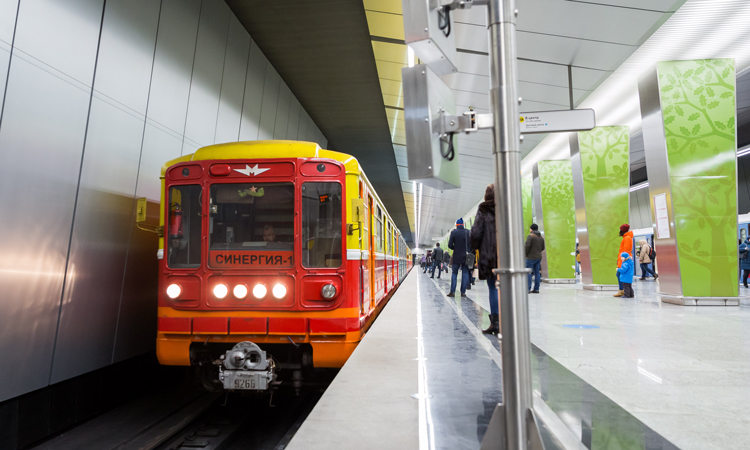Securing safe and efficient transportation for Moscovites
- Like
- Digg
- Del
- Tumblr
- VKontakte
- Buffer
- Love This
- Odnoklassniki
- Meneame
- Blogger
- Amazon
- Yahoo Mail
- Gmail
- AOL
- Newsvine
- HackerNews
- Evernote
- MySpace
- Mail.ru
- Viadeo
- Line
- Comments
- Yummly
- SMS
- Viber
- Telegram
- Subscribe
- Skype
- Facebook Messenger
- Kakao
- LiveJournal
- Yammer
- Edgar
- Fintel
- Mix
- Instapaper
- Copy Link
Posted: 5 December 2018 | Roman Latypov - Moscow Metro | No comments yet
Roman Latypov, First Deputy CEO on Strategic Development and Client Work at Moscow Metro, details some of the operator’s exemplary efforts to modernise safety and security throughout all aspects of its network, from new rolling stock to state-of-the-art track monitoring.


The new Moskva trains will replace older rolling stock on the network
Moscow Metro is the busiest transport operator in the Russian capital. Half of Moscovites use the Metro daily for fast, safe and convenient trips across the city. Trips taken on the metro account for more than 65 per cent of all public transit journeys made in Moscow, with ridership on work days exceeding 8.5 million passengers.
More than 12,000 trains operate daily on the network, with schedule fulfilment exceeding 99 per cent. The metro is also a world leader in coping with traffic intensity, with just 90 seconds between trains and 40 train pairs operating on several lines during peak hours.
Passenger safety – top priority
The well-coordinated, intensive and practically trouble-free operation of the Moscow Metro wouldn’t be possible without the modern security system that supports it.
The success of the current security system is evidenced by the significant reduction of crime on the network since 2015, when inspection zones for passengers were first introduced. The system works in advance to avoid the risk of dangerous situations. Those violating the rules are detected according to a specific criteria as soon as they enter the network. For example, special attention is paid to passengers with oversized baggage.
More than 18,000 cameras help to control the situation across all of Moscow Metro and Moscow Central Circle’s 259 stations. Cameras transmit data to specialists whose job it is to react quickly and decide the next steps. The metro is currently introducing and developing an intelligent CCTV system which will make it possible to detect potentially dangerous situations, such as overcrowding or unattended baggage.
The security system also includes emergency call panels installed at all stations. They can be used at any time to communicate with the Monitoring Center, as well as to give information to Moscow Metro departments or emergency services.
In the event of an emergency inside the carriage, any passenger can immediately contact the driver at the push of a special button. If required, the information received through these channels can be given to the police division that works in close cooperation with other Moscow Metro departments.
Passenger information
Keeping passengers informed is crucial in emergencies. Moscow Metro uses a traditional audio information system and instructional posters in stations and on trains, as well as familiar modern technologies, to keep their users up to date.
Moscow Metro’s online information meets the needs of most passengers, with over 500,000 people following its social media accounts. According to a survey by the CoMET (Community of Metros) benchmarking group, the metro ranks in the top three for its online information.
In 2018, Moscow Metro expanded its capabilities regarding passenger information in emergencies with the launch of a new pilot project. Approximately 6,000 monitors were installed in 1,892 of the network’s carriages. During urgent situations, the monitors display messages on a bright yellow background, about both the current scenario and a further plan of action. In normal operation, the monitors show operational information, like services available at stations, or where to change to surface public transit.
The system enables operators to offer line-specific information on the monitors and aims to provide targeted information for every single car.


Secure trains
Special attention should also be paid to the current rolling stock renewal project, the speed of which makes it unique. Since 2010, more than 40 per cent of Moscow Metro’s fleet has been renewed – that’s more than 1,900 cars to date – and by 2020, another 1,600 cars will have been delivered.
The new ‘Moskva’ trains are the most modern fleet on the Moscow Metro. The first was launched in April 2017 on the Tagansko-Krasnopresnenskaya Line – the metro’s busiest line, transporting around 1.2 million passengers every day. Today, these trains also operate on the Kaluzhsko-Rizhskaya and Filyovskaya lines. There are more than 80 Moskva trains in operation – a number set to increase to 102 by the end of 2018.
The new trains are fitted with new innovations for passenger safety and comfort. For example, the cars are fitted with sliding plug doors with anti-clamping technology, so the doors will open slightly if an object gets trapped. The train also won’t be able to move further until the signal for door closure is activated.
A walkthrough has been added to the model, helping to achieve an even distribution of passengers throughout the train and minimising the risk of falling when switching carriages. In an emergency, passengers can easily get to the head car, equipped with emergency stairs which can be used for fast and safe alighting. Additionally, the walkthrough provides equal air distribution, while a powerful climate control system maintains a comfortable temperature. The cars have more handrails and better illumination to improve accessibility, plus a multimedia information system, interactive displays, video screens and chargers for mobile devices.
The trains are also fitted with modern fire detection and suppression systems. Smoke and temperature detectors help the driver to control the situation online and react quickly in the event of a fire.
A self-diagnostics system in Moskva trains reads hundreds of performance parameters across devices several times a second. The information gathered from these is stored automatically and then comprehensively analysed, which helps to decrease the risk of human error, guarantee traffic regularity and detect pre-failure conditions in equipment.
Diagnostics and infrastructure maintenance
Great attention is paid to the quality of network infrastructure maintenance and renovation – one of the key elements of safe passenger transportation. The special infrastructure directorate, including practically all departments involved in metro operations, is responsible for the maintenance, major overhaul and modernisation of fixed installations, and coordinates the work of all services involved in these activities.
Since the start of 2018, approximately 140km of rails and more than 17,000 sleepers have been replaced on various metro lines. Modern diagnostic technologies ‘Sinergia’ and ‘SMDK-MTR’ help to detect the sections of track that should pass repair works or be replaced as a priority. Sinergia trains operate during the daytime along with passenger trains on all lines with 20 specialists onboard. Their task is to monitor all parameters transmitted by special sensors. These mobile working group spend a minimum of four hours a day on the tracks, inspecting an average of 80km of tracks at 50km/h, which completely excludes human error.
Sinergia cars are fitted with numerous sensors identifying micro flaws in tracks. The new equipment can detect cracks in rails that are 10 times thinner than a human hair. Infrared thermal scanners measure the heat of all the equipment and cables along tunnels, which enables the prevention of fumigations, while thermographs expose any leakage in the tunnel. Any issues uncovered are registered and then eliminated by their responsible departments.
Since 2012, new lines have been designed and built with all modern safety and comfort requirements considered. There is a large implementation of continuous welded rail as well as vibration-absorbing rail pads, known as ‘silk tracks’. These reduce noise and increase the smoothness of operation while decreasing the pressure on bogies.
Moscow Metro will renew a further 265km of tracks by 2020 – 35 per cent of the total length of all lines – replacing normal rails with silk tracks. This continuous welded rail has already been laid on central sections of both the Moscow Metro and Moscow Central Circle, with plans to implement it along the entire Koltsevaya Line as well.
During the last three years, the number of operational failures has been significantly reduced. The number of track units in need of renewal has halved, giving Moscow Metro a chance to improve passenger services.
Moscow Metro will keep modernising infrastructure, updating rolling stock and implementing new passenger services to keep Moscovites and visitors safe and satisfied.
Biography


The rest of this article is restricted - login or subscribe for free to access
Thank you for visiting our website. To access this content in full, you'll need to login or subscribe.
It's completely free to subscribe, and in less than a minute you can continue reading. If you've already subscribed, just login.
Why subscribe? Join our growing community of thousands of industry professionals and gain access to:
- Quarterly issues in print and/or digital format
- Case studies, whitepapers, webinars and industry-leading content
- Breaking news and features
- Our extensive online archive of thousands of articles and years of past issues
All for free!
Click here to Subscribe today Login here
Related topics
Fleet Management & Maintenance, Infrastructure & Urban Planning, Passenger Experience, Public Transport, Vehicle & Passenger Safety
Issue
Issue 4 2018
Related modes
Metro
Related organisations
Moscow Metro
Related people
Roman Latypov







